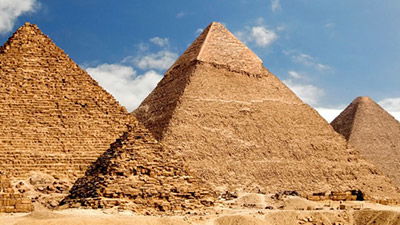Casting Stones at the Pyramids
New evidence regarding the advanced technology evident in the ancient Egyptian pyramids is consistent with the Bible’s account of history. The evolutionary model of the history of early man presents man as an ignorant primitive gradually acquiring intellectual skills and technology. However, the biblical description of mankind’s dispersal from the Tower of Babel is consistent with the findings of advanced technology among ancient people all over the world.1 Indeed, God’s own assessment of the people at Babel was that “nothing will be restrained from them, which they have imagined to do” (Genesis 11:6).2 Since God created Adam with perfect intellect, those generations closer to Adam in time were intellectually superior. Therefore, they were able to develop the technology needed to build impressive things like a massive ark and the pyramids.
Today’s technology would be hard-pressed to duplicate the quality, precision, and endurance of these ancient constructions.
Modern scientists studying the pyramids marvel at the precise leveling of the bases, the equally precise angles of the four sides necessary for the pyramids to peak at the summit, and the perfect fit of the stones. Today’s technology would be hard-pressed to duplicate the quality, precision, and endurance of these ancient constructions. Modern efforts to quarry stones with this level of precision would break four out of five stones.3
Recent analysis of pyramid fragments4 strongly suggests that some of the stones were cast, not quarried. Comparison of the chemical makeup of these fragments to that of stone from nearby quarries shows them to be different. Dr. Michel Barsoum, reporting his findings in the Journal of the American Ceramic Society, has demonstrated that the relative amounts of the elements silicon, calcium, and magnesium in the pyramids fragments differ markedly from the ratios in limestone from the quarries. In addition, these elements are chemically combined in a way not found in nature.5
Furthermore, the ground-up limestone components of the pyramid concrete have chemical characteristics seen only in man-made stone. Specifically, the tiny particles of limestone are hydrated; that is, they are chemically bound to elements of water.6 When limestone crystallizes naturally, these elements of water disappear, but rapid crystallization in man-made limestone traps these elements in the crystals. Such hydrated limestone is the type of limestone which Dr. Barsoum, using electron microscopy, found in the pyramid fragments, demonstrating that the fragments consist of man-made material.7
Dr. Joseph Davidovits proposed the idea that the Egyptians used cast stones8 and even suggested that more advanced technological analysis such as electron microscopy would be required for confirmation.9 Dr. Davidovits has since demonstrated a technique for casting blocks which could dry without tell-tale wood grain marks from the molds.10 Adding support to this theory, analysis of stone from a pyramid passageway has revealed air bubbles like those that form in plaster.11
Dr. Barsoum suggests these cast stones would have been most useful for building the perfectly-fit casings of the pyramids and for the portions at great elevation, as casting stones in those places would be more practical than hauling them up steep ramps.
If the Egyptians cast, rather than quarried and cut, at least some of the massive stones in the pyramids, rediscovery of their secrets could provide economical, nonpolluting building material alternatives for third-world countries.12 Although the idea of cast stone flies in the face of traditional Egyptology, Dr .Barsoum’s evidence adds great weight to this hypothesis and should spur further research to confirm his findings and hopefully develop modern equivalents.
Footnotes
- Down, David, The pyramids of ancient Egypt, Creation 26(4):44–49, September 2004.
- Whitcomb, John, Babel, Creation 24(3):31–33, June 2002.
- Morris, Margie, Letters to the Editor, Creation 14(3):5, June 1992.
- Dr. Barsoum reports three different pyramid sources for his samples and took great care to avoid contamination. The samples were all obtained from the precision-fit covering layers.
- M.W. Barsoum, A. Ganguly, G. Hug (2006) “Microstructural Evidence of Reconstituted Limestone Blocks in the Great Pyramids of Egypt” Journal of the American Ceramic Society 89(12), 3788–3796. Abstract available at www.blackwell-synergy.com/doi/abs/10.1111/j.1551-2916.2006.01308.x.
- Ibid.
- Pyramids were built with concrete rather than rocks, scientists claims, Times Online, December 1, 2006.
- Creation magazine published a report on Dr. Davidovits’s theory in the Vol.11, No. 1, Dec. ’88–Feb. ’89 issue.
- Davidovits, Joseph, The New History of the Pyramids, Chapter one: ftp://ftp2.geopolymer.org/geopolyme/pyramid_chapt1.pdf, 2004. Return.
- Video footage dramatizing the demonstration available at www.geopolymer.org/archaeology/pyramids/pyramids-4-videos-download-chapter-1. Return.
- Backing for ready-mix pyramids, in Focus: News of interest about creation and evolution, Creation 13(3):5–8, June 1991 (reporting on research by Edward Zeller, director of radiation physics at the University of Kansas Space Technology Center).
- Riddle of the great pyramids of Giza: Professor finds some building blocks were concrete, Science Daily, www.sciencedaily.com/releases/2006/12/061209122918.htm, December 9, 2006.

Answers in Genesis is an apologetics ministry, dedicated to helping Christians defend their faith and proclaim the good news of Jesus Christ.
- Customer Service 800.778.3390
- Available Monday–Friday | 9 AM–5 PM ET
- © 2025 Answers in Genesis




